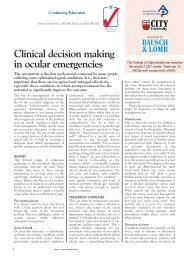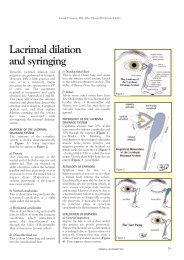Intraocular lens implantation - Optometry Today
Intraocular lens implantation - Optometry Today
Intraocular lens implantation - Optometry Today
You also want an ePaper? Increase the reach of your titles
YUMPU automatically turns print PDFs into web optimized ePapers that Google loves.
Sponsored by<br />
Module 3 Part 11<br />
to the iris. The third generation of IOLs,<br />
independently produced by Epstein and<br />
Binkhorst, used the pupillary part of the iris<br />
diaphragm for anatomical fixation. However,<br />
this led to luxation of the <strong>lens</strong> if the pupil<br />
dilated unexpectedly. These pupillary fixated<br />
IOLs are now obsolete. A second development<br />
was the use of a Medallion <strong>lens</strong> fixed to the<br />
iris by a suture, however late degradation of<br />
the suture led to dislocation of the <strong>lens</strong>es. The<br />
next development was the Iris-claw <strong>lens</strong> with a<br />
fixating mechanism based on the capture<br />
of a fold of iris tissue at the two ends of the<br />
IOL.<br />
Modern anterior chamber<br />
IOLs (1970 to present day)<br />
For an anterior chamber <strong>lens</strong> to be safe and<br />
effective there should be minimal contact with<br />
the drainage angle, stability within the<br />
anterior chamber with no movement in the<br />
angle, no iris chafing and no endothelial<br />
touch.<br />
Modern anterior chamber IOLs were<br />
designed to achieve this by using flexible open<br />
loop <strong>lens</strong>es made of PMMA. They have the<br />
advantage of not requiring an intact posterior<br />
capsule for <strong>implantation</strong> and can be implanted<br />
into eyes even after posterior capsule rupture<br />
(occurring during complicated cataract surgery<br />
or after intracapsular surgery). Modern<br />
anterior chamber IOLs allow far better fixation<br />
Table 2<br />
Advantages and disadvantages of the IOL types<br />
www.optometry.co.uk<br />
than the early anterior chamber IOLs and<br />
corneal complications are rare. However, they<br />
are associated with a higher incidence of CMO<br />
and retinal detachment than posterior<br />
chamber IOLs.<br />
Modern posterior chamber<br />
IOLs (1975 to present day)<br />
The first posterior chamber IOLs were made of<br />
PMMA with either PMMA, polypropylene or<br />
polyamide haptics. They require the presence<br />
of a posterior capsule and can either be placed<br />
in the sulcus or the capsular bag. Capsular bag<br />
placement has been shown to be superior to<br />
sulcus placement in terms of centration and<br />
the rate of posterior capsular opacification<br />
(PCO). The advantage of posterior chamber<br />
IOLs is that they are placed in the position of<br />
the original crystalline <strong>lens</strong> leading to a more<br />
physiological situation with optical benefits.<br />
An additional advantage is that posterior<br />
chamber IOLs are situated away from the<br />
delicate structures of the anterior chamber<br />
including the cornea, the aqueous outflow<br />
channels, the iris and the ciliary body. This<br />
leads to a lower incidence of corneal problems,<br />
UGH and pupil block. When the IOL is placed<br />
within the capsular bag, contact with uveal<br />
tissues is completely avoided. The intact<br />
posterior capsule is associated with a<br />
decreased incidence of CMO and retinal<br />
detachment 5 .<br />
Type of IOL Advantages Disadvantages<br />
Ridley PC IOL optical uveitis<br />
secondary glaucoma<br />
hyphaema<br />
decentration/dislocation<br />
Early AC IOLs do not require posterior capsule - corneal complications:<br />
(rigid, closed loop) capsule usually removed therefore (decompensation, oedema,<br />
no PCO<br />
pseudophakic bullous<br />
keratopathy, IOL corneal touch)<br />
CMO, uveitis, UGH<br />
subluxation, dislocation<br />
Iris-supported IOL do not require posterior capsule iris complications: (iris chafing and<br />
erosion, pupil changes, pupillary block,<br />
PAS - Peripheral Anterior Synechiae)<br />
Modern AC IOLs do not require posterior capsule CMO retinal detachment<br />
(flexible, open loop) better fixation corneal complications rare<br />
Modern PC IOLs less corneal problems require intact zonules & posterior capsule<br />
less CMO<br />
less retinal detachment<br />
less UGH<br />
less pupil block<br />
optical<br />
Foldable IOLs small incision expensive<br />
less astigmatism<br />
decentration<br />
quicker rehabilitation<br />
rupture bag when unfolding<br />
safer<br />
spontaneous dislocation<br />
IOL material<br />
PMMA is the gold standard material for use in<br />
IOL manufacturing. It was the first material<br />
to be used, and has withstood the test of<br />
time as the majority of IOLs implanted<br />
worldwide today are still made of it. PMMA<br />
benefits from inducing a minimal intraocular<br />
inflammatory reaction, is not adversely<br />
affected by ultraviolet light and is not<br />
biodegradable in the eye. Because of this, it<br />
maintains a smooth surface even when in<br />
contact with vascular and metabolically<br />
active tissue. PMMA is also relatively<br />
inexpensive. However, one disadvantage is<br />
that it is rigid and so requires a larger<br />
incision for insertion than the newer foldable<br />
materials. Surface modifications of PMMA<br />
with heparin have been found to reduce the<br />
inflammatory cell precipitates found on the<br />
anterior IOL surface post-operatively,<br />
therefore, this <strong>lens</strong> modification is useful in<br />
patients expected to have more precipitation,<br />
such as uveitics.<br />
With the development of small incision<br />
phacoemulsification surgery, a whole new<br />
range of foldable <strong>lens</strong> implant materials have<br />
been developed. Early foldable IOLs, however,<br />
were not successful, because they elbowed<br />
and folded as the capsular bag contracted.<br />
The use of capsulorhexis dramatically reduces<br />
this decentration of foldable materials.<br />
The advantages of foldable IOLs are due<br />
to the smaller incision size required for their<br />
insertion. They are usually self-sealing and<br />
do not require suturing. Smaller incisions<br />
produce less astigmatism, allow quicker<br />
visual rehabilitation with stable refraction<br />
after a couple of weeks compared to six to<br />
eight weeks for larger wounds, and are safer<br />
with less iris prolapse and dehiscence. The<br />
disadvantage of foldable IOLs is that they are<br />
more expensive than PMMA and have a<br />
higher incidence of decentration if a<br />
continuous curvilinear capsulorhexis is not<br />
used.<br />
When a new IOL material is developed, its<br />
biocompatibility needs to be studied. IOL<br />
biocompatibility within the human eye has<br />
three major aspects. These are the effect on<br />
the blood aqueous barrier, the cellular<br />
reaction on the anterior surface of the <strong>lens</strong>,<br />
and the effect on the <strong>lens</strong> capsule. Blood<br />
aqueous barrier changes can be assessed by<br />
the amount of inflammation (flare and cells)<br />
within the anterior chamber, which can be<br />
quantified using the laser flare and cell<br />
meter. Cells on the anterior surface of the<br />
implant can be examined post-operatively<br />
using specular microscopy and have been<br />
used extensively as a method of assessing<br />
the foreign body response to the IOL. The<br />
effect of the IOL on the capsule consists of<br />
<strong>lens</strong> epithelial cell proliferation and<br />
metaplasia leading to anterior and posterior<br />
capsular opacification, and IOL decentration.<br />
PCO occurs in 20-50% of patients two years<br />
after cataract surgery (Figure 3). It leads to a<br />
progressive deterioration in visual acuity and<br />
29
















